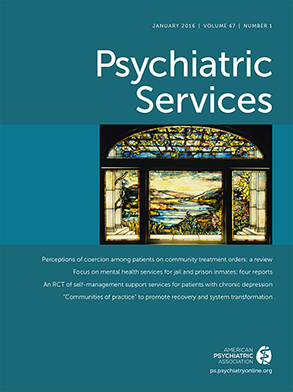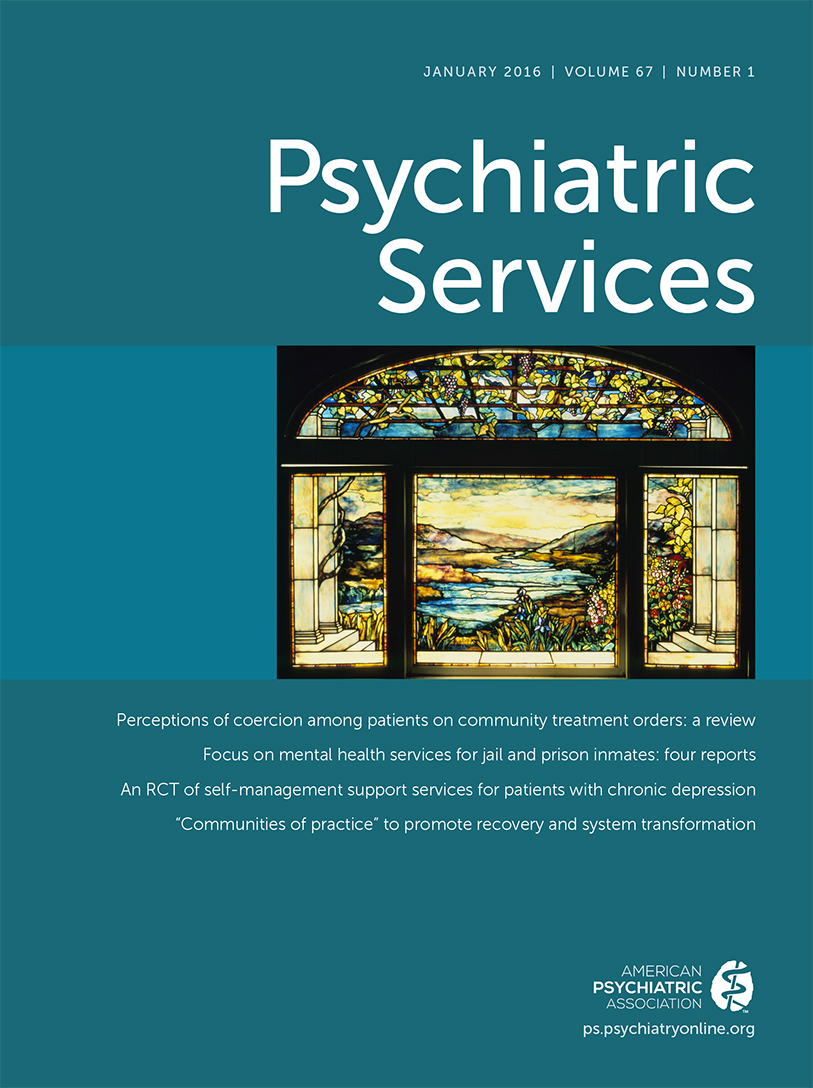County jail inmates with mental disorders and general medical problems are often caught in a most inhospitable environment—and the problem is growing. Today there are more citizens with mental illness in jails and prisons than in hospitals (
1), and American Psychiatric Association (APA) President Renée Binder, M.D., described jails and prisons as “the front lines of treatment for mental illness” (
2). Whereas the roots of the problem can be traced to economic issues arising from deinstitutionalization in the 20th century, it would be facile to argue that emptying asylums was wrong or that it was the sole cause of the subsequent transinstitutionalization.
Inadequate general medical and mental health care in county jails is a vexing issue that demands urgent reform. It is especially poignant when one considers that many inmates are either pretrial detainees lacking bail money or persons with serious mental illness unable to cope with the demands of community life. This landscape eerily approximates what Dorothea Dix campaigned against in the mid-19th century. Given many counties’ reluctance to respond to grievances about inadequate care, largely because of cost, the courts are an alternate solution. In this column, we describe a near rapprochement between inmates and the California county that they sued.
In
Hernandez v. County of Monterey (
3), inmates sued the county and its contract medical group for unlawfully inadequate care, with the aid of public and private attorneys and the American Civil Liberties Union. Federal Magistrate Judge Paul Singh Grewal, ultimately granting relief to the inmates, began his opinion with an editorial: “In the midst of this litigation over the conditions of confinement at the Monterey County Jail, the parties did something different. They did something commendable. They cooperated.” The parties agreed to use a panel of experts to make recommendations and then got stuck on the implementation. The district court magistrate judge, perceiving urgency and believing the scales tipped in favor of the plaintiffs, broke the logjam, ordering what we consider important reforms.
To prevail in a federal civil-rights matter against a jail or prison, the plaintiff must prove that the defendant displayed “deliberate indifference” to the needs of the inmate, thus invoking the Eighth Amendment’s ban on cruel and unusual punishment. The standard is whether the prison officials disregarded a substantial risk of harm by failing to meet the inmate’s needs. The inmates in Hernandez also claimed violations of the Fourteenth Amendment (equal protection clause) and the Americans with Disabilities Act (ADA).
The Case
Since 1984, the County of Monterey has had in its jail a contract medical group for health care screening and treatment. Although serious problems in health and safety were publicized—and many admitted by the county—an investigation began only in early 2012. Counsel for the plaintiffs at the Salinas-based facility, representing pretrial and sentenced inmates with various health and disability access issues, filed a complaint in May 2013. Several weeks later, the court stayed the litigation until January 2014, giving the parties time to agree on consultants and to arrive at a settlement. The parties jointly retained independent experts in four areas: general medical care, mental health care, security, and disability accommodations and access. They also reserved the right to litigate if no accord was reached on implementation. The experts included a physician and a forensic psychologist but not a psychiatrist. They conducted consultations and submitted reports by the end of 2013.
The medical expert cited numerous deficiencies, including inadequate clinical staffing at the jail, with no contingencies for absences (
4). The report contained items relevant to psychiatric patients; for example, the “inappropriate” policy of discontinuing inmates’ previous medications. The jail’s health care policies were “generic,” ignoring special needs of persons with mental illness, intellectual disability, dementia, and other conditions. There was lack of attention to inmates with substance-related problems: “[N]urses use a poorly written detoxification protocol which is inconsistently followed. This has the appearance, based on chart reviews, of nurses making up rules as they go along.” The need for detoxification was usually determined by correctional officers instead of nurses or physicians, who assigned inmates to “sobering cells.” Officers made decisions on placement in isolation of individuals who could be at risk of harm to self or others. Management of substance withdrawal fell to officers or to nurses without physician supervision. The consultant recommended that alcohol and opiate withdrawal protocols be separated and that the use of benzodiazepines for withdrawal conform to a community standard.
The psychologist reviewing mental health care concluded that the jail’s policies and practices placed inmates at risk of serious harm (
5). The central issues were self-harm and psychic injuries caused by isolation in administrative segregation. There were simple suggestions, such as suicide screening: “[A]dd the following (or similar) questions to the Intake Health Screening form: a. Have you been admitted to a hospital during the past five years? . . . b. Have you ever had problems with depression? Are you feeling depressed now? c. Have you ever had mental health counseling or treatment?” (
5). Another recommendation was that inmates in administrative segregation have access to mental health care, with review for less restrictive housing “at least once monthly.” The recommendation is consistent with the limited data on the adverse effects of restrictive housing on inmates’ mental stability (
6). The experts on ADA violations and other disability rights found a range of violations: lack of security (
7), dated architecture, poor access to programming and exercise, and lack of accommodations for inmates with communication impairments (
8).
The Arguments, Ruling, and Settlement
Having received the experts’ reports and perceiving the possibility of imminent and ongoing danger to inmates, the plaintiffs added several inmates’ names and issued an amended complaint on April 11, 2014. The defendants demurred, citing improper analyses of data—for example, on suicide rates. The medical group, while not denying the deficiencies at the facility, argued that it was not responsible. The medical group asserted that several individual plaintiffs’ claims had been rendered moot by the prisoners’ having been released and that the ADA’s Title III did not apply because the medical group did not “operate” the facility and the jail was not open to the public (
9). The inmates countered that the transitory nature of the jail population had no effect on the validity of the complaint, which concerned long-term issues rather than snapshots, and that the medical group indeed operated the services in question at a facility that was properly characterized as a “public accommodation” under the ADA (
9). In September 2014, the court rejected the defendants’ motion to dismiss the complaint. The plaintiffs sought a preliminary injunction to begin remediation per the consultants’ recommendations.
Ultimately, Judge Grewal granted injunctive relief on April 14, 2015 (
3). He based the decision on four points: that the plaintiffs were likely to succeed, that they were likely to be harmed without relief, that the balance of equities tipped in their favor, and that an injunction was in the public interest (
3). On May 11, the court announced that the parties had settled, with the defendants to begin implementation within months (
10). The action items apart from mental health care included enhanced intake health screening; tuberculosis detection and control; safety cells; medication continuity; adequate staffing; timely access to medical and dental care; safety measures (violence reduction and cameras), and disability accommodations, including sign language interpreters (
10). At first glance, these items represent ordinary elements of sound jail-based policies. The experts, however, uncovered significant deficits in care that made their recommendations necessary. It is apparent that persons working within the system had become inured to its faults.
Discussion
Although the
Hernandez settlement does not offer revolutionary suggestions, its terms represent a path forward. Significantly, when viewed in the context of the prevailing political attitudes toward criminal justice reform, it could be a harbinger of meaningful change. Prisoners’ rights have been a prominent legal issue, but one that has not translated into reforms within many facilities. Some facilities are more advanced than Monterey’s, as illustrated in Dr. Binder’s description of the APA Board of Trustees’ visit to San Quentin State Prison (
2), but many are not.
Obstacles to reform, besides counties’ reluctance to assume the associated financial burdens, include courts’ hesitancy about being overly intrusive in local correctional matters. The Prison Litigation Reform Act (PLRA) of 1996 (
11) requires that all local remedies be exhausted before federal courts act (
12). It took years of litigation for California to be ordered to reduce its prison population, pursuant to the PLRA, in response to claims that overcrowding was a form of cruel and unusual punishment (
13). As Judge Grewal noted in
Hernandez, the litigants are to be applauded for agreeing on a process for identifying deficiencies and not reverting to a battle of the experts. The judge must also be acknowledged for his timely injunctive relief, tempering justice with mercy.
Where is psychiatry in all of this? Although no one is looking to judges to micromanage mental health evaluation and treatment in jails, we are concerned that psychiatry was not consulted directly in the Monterey County case. Perhaps it was because mental health care in jails is often led by psychologists and nurses, with psychiatrists as nominal medical directors but only occasional participants. The disengagement of forensic psychiatry from correctional psychiatry was addressed recently by Glancy (
14), who has called for psychiatric leadership within the corrections system. We agree that dedicated input by psychiatrists into policies and procedures, as well as direct clinical care in correctional settings, must be given greater priority.
The fact that corrections officers had been triaging substance withdrawal in Monterey County is cause for alarm. We are pleased, however, that the medical consultant appropriately rejected the one-size-fits-all protocol that involved use of a “sobering cell,” calling attention to the different needs of persons with opiate and alcohol use disorders. It was also laudable to question the practice of simply erasing previous medication prescriptions in favor of whatever is on the local formulary. This represents rational and humane treatment and should serve as a model for correctional policies and procedures. At the time of writing, Los Angeles County had also entered into an agreement to reform its correctional mental health services, with emphases on preventing suicide and reducing inmate abuse.
Substantial attention is needed to address the infrastructure deficits that have contributed to transinstitutionalization. Several positive currents, in addition to litigation, are converging on the problem. One is a renewed focus on economics. Housing persons with mental illness in jails is expensive, inefficient, and disruptive (
15). President Obama, recognizing the overuse of prisons for social control, recently visited a federal correctional institution in Oklahoma, the first prison visit for a sitting president. And recently, a psychologist became warden of the Cook County (Illinois) Jail, raising hopes of increased sensitivity to mental health issues. When justice systems are insensitive to the dynamics of behavior and mental disorders, persons with serious mental illnesses can be overlooked. We are hopeful that these trends and the court decision ordering improvements at the Monterey County Jail are signals of mindfulness about the needs of citizens with mental disorders.

